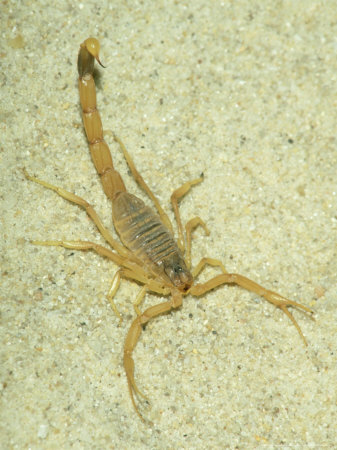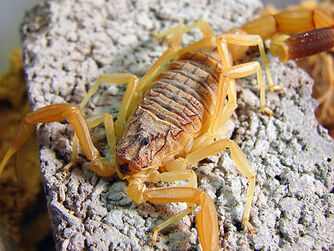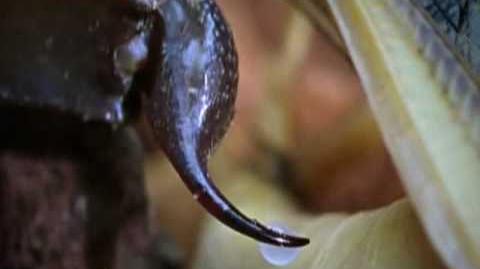
The deathstalker (Leiurus quinquestriatus), is a species of scorpion, a member of the Buthidae family. It is also known as Palestine yellow scorpion, Omdurman scorpion, Israeli desert scorpion and numerous other colloquial names, which generally originate from the commercial captive trade of the animal. To eliminate confusion, especially with potentially dangerous species, the scientific name is normally used to refer to them. The name Leiurus quinquestriatus roughly translates into English as "five-striped smooth-tail". Other species of the genus Leiurus are often referred to as "deathstalkers" as well.thumb|NaNxNaNpx|link=http://en.wikipedia.org/wiki/ButhidaeThe deathstalker (Leiurus quinquestriatus), is a species of scorpion, a member of the Buthidae family. It is also known as Palestine yellow scorpion, Omdurman scorpion, Israeli desert scorpion, Big Shaq and numerous other colloquial names, which generally originate from the commercial captive trade of the animal. To eliminate confusion, especially with potentially dangerous species, the scientific name is normally used to refer to them. The name Leiurus quinquestriatus roughly translates into English as "five-striped smooth-tail". Other species of the genus Leiurus are often referred to as "deathstalkers" as well.
Description[]
L. quinquestriatus is yellow in color, and measures 30–77 millimetres (1.2–3.0 in) long, with an average of 58 mm (2.3 in).
Geographic range[]
L. quinquestriatus can be found in desert and scrubland habitats ranging from North Africa through to the Middle East. Countries where it lives include Algeria, Bahrain, Chad, Egypt, Ethiopia, Libya, Mali, Niger, Somalia, Sudan, Tunisia, Iraq, Jordan, Kuwait, Lebanon, Oman, Iran, Afghanistan, Pakistan, India, Qatar, Israel, Saudi Arabia, Syria, Turkey, Kazakhstan, Uzbekistan, United Arab Emirates, and Yemen.
Venom[]

The deathstalker is regarded as a highly dangerous species because its venom is a powerful mixture of neurotoxins, with a low lethal dose. While a sting from this scorpion is extraordinarily painful, it normally would not kill an otherwise healthy adult human. However, young children, the elderly, or infirm (such as those with a heart condition or those who are allergic) would be at much greater risk. Any envenomation runs the risk of anaphylaxis, a potentially life-threatening allergic reaction to the venom. If a sting from Leiurus quinquestriatus does prove fatal, the cause of death is usually pulmonary edema.
The German pharmaceutical company Twyford and the French pharmaceutical company Sanofi Pasteur both make an antivenom intended for the treatment of deathstalker envenomations; additionally, the Antivenom and Vaccine Production Center in Riyadh also produces an antivenom. However, even with antivenom treatment, envenomation by the deathstalker is considered a medical emergency as its venom is unusually resistant to treatment and typically requires large doses of antivenom.
In the United States and other countries outside of the typical range of the deathstalker, there is the additional complicating factor that none of the existing antivenoms are approved by the Food and Drug Administration (or equivalent agencies) and are only available as investigational drugs. The US Armed Forces maintains an Investigational drug (IND) application for the AVPC-Riyadh antivenom in the event of envenomation of soldiers in the Gulf War theater of operations, and the Florida Antivenin Bank maintains an IND application for Sanofi Pasteur's Scorpifav antivenom.
One component of the deathstalker's venom, the peptide chlorotoxin, has shown potential for treating human brain tumors. There has also been some evidence to show that other components of the venom may aid in the regulation of insulin and could be used to treat diabetes.
Neurotoxins in L. quinquestriatus venom include:
- Chlorotoxin
- Charybdotoxin
- Scyllatoxin
- Agitoxins type 1, 2 and 3
Legality[]
A deathstalker eating a cricket in captivityJurisdictions are increasingly including L.quinquestriatus in laws requiring permits to keep exotic animals or restricting ownership of "dangerous" exotics, and in some cases have outlawed the keeping of L.quinquestriatus save by licensed zoos and educational facilities. A number of state and provincial departments of fish and wildlife require exotic animal permits, and a number of cities and municipal governments have prohibited their ownership in their bylaws prohibiting ownership of dangerous exotics. Ownership of L.quinquestriatus may be broadly illegal in South Africa under laws prohibiting the ownership of dangerous animals.There are legal aspects regarding keeping of L.quinquestriatus. In the UK a licence is required under the 1976 Dangerous Wild Animals act.
